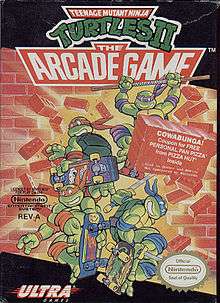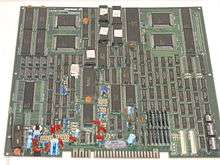Teenage Mutant Ninja Turtles (arcade game)
| Teenage Mutant Ninja Turtles | |
|---|---|
 Cover artwork of the NES version, which was retitled Teenage Mutant Ninja Turtles II: The Arcade Game. | |
| Developer(s) | Konami |
| Publisher(s) | Konami, Image Works, Ultra Games, Ubisoft |
| Distributor(s) |
Konami Viacom Media Networks (XBLA) |
| Composer(s) |
Mutsuhiko Izumi (Arcade) Miki Higashino (Arcade) Kozo Nakamura (Arcade, NES) Yasuhiko Manno (NES) |
| Series | Teenage Mutant Ninja Turtles |
| Platform(s) | |
| Release date(s) | |
| Genre(s) | Beat 'em up |
| Mode(s) |
Single-player Up to four players, simultaneous |
| Cabinet | Upright |
| Display | Horizontal, raster, standard resolution |
Teenage Mutant Ninja Turtles, released as Teenage Mutant Ninja Turtles: Super Kame Ninja (ティーンエイジ・ミュータント・ニンジャ・タートルズ 〜スーパー亀忍者〜 Tīneiji Myūtanto Ninja Tātoruzu: Sūpā Kame Ninja) in Japan and Teenage Mutant Hero Turtles in Europe, is a side-scrolling beat-'em-up released by Konami as a coin-operated video game in 1989. It is based on the first Teenage Mutant Ninja Turtles animated series which began airing in the winter of 1987. The original coin-operated game was distributed to the arcades in two variants: a standard 2-player version that allowed either player to choose their character and a deluxe 4-player version with each player controlling a different character. Home versions of the game were released for various platforms.
Konami followed the game up with an NES-exclusive title, Teenage Mutant Ninja Turtles III: The Manhattan Project, and an arcade sequel, Teenage Mutant Ninja Turtles: Turtles in Time.
Gameplay
_gameplay.png)

The player chooses from one of the four Ninja Turtles: Leonardo, Michelangelo, Donatello, and Raphael. After Shredder kidnaps the Turtles' friend April O'Neil and their mentor Splinter, they must give chase, save their comrades, and defeat the evil Shredder. Up to four players (two in some versions) can take control of any of the Turtles. Donatello has slower attacks but a longer range, Michelangelo and Raphael have faster attacks but a shorter range, and Leonardo is a well-rounded Turtle with average range and speed.
The eight-way joystick controls the movements of the Turtle, the jump button makes them jump and the attack button makes them hit in front of them using their weapon. In addition to this, some combinations are possible. The Turtles can throw Foot soldiers overhead, and by pressing the jump and attack buttons, a special attack is performed. Raphael rolls along the ground and finishes with a kick, while the other Turtles do a sweeping jump attack with their weapons. Turtles can also spring off the wall in certain areas. Enemies can be defeated more quickly by slamming them into walls or solid objects. Many objects such as traffic cones, parking meters, fire hydrants and exploding oil drums can be hit or damaged with attacks in order to help defeat nearby enemies. In the attract mode, the game showed the first part of the cartoon opening, along with a portion of the Teenage Mutant Ninja Turtles theme song.
The majority of the enemies the Turtles must face are the Foot Soldiers. They wear a different colored uniform depending on what weapon they have. The purple-clad Foot Soldiers, the most standard of them, also have the ability to hold the Turtles from behind, draining their health and leaving them open to attack by the other Foot soldiers. The bosses in the game includes Bebop and Rocksteady (individually and together), Baxter Stockman, Granitor, General Traag, Krang, and Shredder himself.
Home versions
Nintendo Entertainment System
This game was ported to the NES in 1990 under the title Teenage Mutant Ninja Turtles II: The Arcade Game in North America and Australia, and as Teenage Mutant Hero Turtles II: The Arcade Game in Europe. The numbered title was due to a prior Teenage Mutant Ninja Turtles video game also produced by Konami for the NES; the Famicom version was simply titled Teenage Mutant Ninja Turtles, since the first NES Turtles game was released under a different Japanese title (while retaining the TMNT license).
This version includes two new levels (the first part of Scene 3 and all of Scene 6), which feature new enemy characters, including two new bosses: Tora (a dog-like "blizzard beast") and Shogun (a robotic samurai), both characters created for the game. Most of the original stages from the arcade version were extended as well and the second half of Scene 3, the parking garage stage, replaces the arcade version's end battle with Bebop and Rocksteady with a battle against the mutated fly form of Baxter Stockman. The NES version of the game was once slated for release on the Wii Virtual Console, but was quietly canceled. The NES port also appeared in Nintendo's PlayChoice-10 arcade system.
The NES version featured notable product placement advertising: Pizza Hut logos. There were also Pizza Hut coupons in the game's manual.
GamesRadar ranked it the 25th best NES game ever made. The staff attributed the Ninja Turtles continued success to the game and praised its visuals, audio, and combat system.[1]
Home computers
The computer ports of the arcade game were released by Image Works and ported by Probe Software in 1991 for the ZX Spectrum, Amiga, Amstrad CPC, Atari ST, PC and Commodore 64. The title was changed to Teenage Mutant Hero Turtles: The Coin Op in the European versions (Hero being the re-branding of the license in Europe due to censorship issues) and lacked the extra stages and bosses from the NES game.
Xbox Live Arcade
An Xbox Live Arcade version of the game was released under the name TMNT 1989 Classic Arcade on March 14, 2007, published by Ubisoft and ported by Digital Eclipse but has since been removed from Xbox Live Arcade. The game was priced at 400 Microsoft Points. Like other classic arcade games on the Xbox 360 platform, portions of the original arcade game were emulated with network code and other new features added. Players could earn achievements as well as play 2-4 player co-op (both online and offline). Certain aspects, such as the character select screen, were based on images from the 2007 movie.
Teenage Mutant Ninja Turtles 2: Battle Nexus
The arcade version of Ninja Turtles is included as a hidden bonus game in Teenage Mutant Ninja Turtles 2: Battle Nexus for the PlayStation 2, Xbox, and GameCube. The version featured in the game is a port of the original arcade version, but with altered music and most of the voice clips edited out. The game is unlocked by finding an antique in Stage 9-1; the antique turns out to be the original arcade machine.
Reception
| Reception | ||||||
|---|---|---|---|---|---|---|
| ||||||
Zzap! reported on the game after it appeared at Amusement Trades Exhibition International, calling it a "great coin-op which is best in four player mode."[3] Time's Jared Newman named to his list of "14 Important Arcade Games Not Available for iPhone or iPad", citing the game's pioneering 4-player simultaneous play.[4]
Sequel
Official sequel: Teenage Mutant Ninja Turtles: Turtles in Time
References
- ↑ "Best NES Games of all time". GamesRadar. 2012-04-16. Retrieved 2013-12-05.
- ↑ Irwin, Jeffl. "Teenage Mutant Ninja Turtles II: The Arcade Game - Review". Allgame. Retrieved May 28, 2013.
- ↑ "ATEI Show Report." ZZAP! March 1990. p.39.
- ↑ Newman, Jared (February 24, 2012). "14 Important Arcade Games Not Available for iPhone or iPad". Time. Retrieved January 10, 2013.
External links
- The game's instruction manual
- Teenage Mutant Ninja Turtles at the Killer List of Videogames
- Teenage Mutant Ninja Turtles at MobyGames
- Complete game video (NES) on archive.org
- Ninja Turtle Games